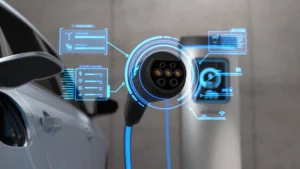
Home / EV Charging News / What Battery Storage Means for EV Drivers
Battery storage is revolutionizing the energy landscape, particularly for electric vehicle (EV) drivers. As EVs become more mainstream, the need for efficient and sustainable energy solutions grows. Battery storage not only impacts how we charge and power electric vehicles but also influences broader aspects such as energy consumption, cost savings, and grid resilience. This article explores the role of battery storage for EV drivers, highlighting its benefits and implications for the future.
One of the key advantages of battery storage for EV drivers is its ability to optimize charging efficiency. With the integration of battery storage systems, EV drivers can store electricity during off-peak hours when energy rates are lower and then use this stored energy to charge their vehicles. This ensures a more cost-effective and efficient charging process, minimizing the need to rely on the grid during peak demand periods.
For those who have home solar panels, battery storage becomes even more valuable. Solar energy generated during the day can be stored in a battery system and used to charge the EV at night. This reduces dependence on the traditional energy grid, lowering energy costs and promoting a sustainable lifestyle.
Battery storage systems can significantly reduce electricity costs for EV owners. By storing energy when electricity rates are low, such as during nighttime or periods of surplus renewable energy, drivers can avoid paying higher prices during peak hours. In regions with time-of-use (TOU) pricing, where energy rates fluctuate based on demand, battery storage allows EV drivers to manage their energy usage more strategically.
Additionally, battery storage systems can help drivers avoid demand charges—extra fees based on peak energy usage. By discharging stored energy during times of high consumption, EV drivers can minimize the impact of these charges, leading to substantial savings over time.
Battery storage plays a crucial role in enhancing grid resilience, which directly benefits EV drivers. As extreme weather events and grid disruptions become more common, having a reliable source of stored energy can be invaluable. EV drivers with home battery storage systems can use their stored power to keep essential systems running during blackouts, ensuring their vehicle remains charged and ready for use.
In addition to providing backup power during outages, battery storage helps stabilize the grid by reducing strain during peak demand. When combined with renewable energy sources, such as solar or wind, battery storage reduces reliance on fossil fuels, supporting a cleaner and more resilient energy system.
Battery storage is essential for integrating renewable energy into the charging infrastructure. As more drivers switch to electric vehicles, the demand for clean energy increases. However, renewable sources like solar and wind are intermittent, meaning they don’t always generate electricity when it’s needed. Battery storage helps bridge this gap by storing excess energy produced during periods of high renewable output and releasing it when demand is high.
For EV drivers, this means that charging their vehicles can become more sustainable, with a greater proportion of energy coming from clean sources. This shift not only reduces the environmental impact of EV charging but also helps accelerate the transition to a low-carbon economy.
One of the most exciting developments in battery storage for EV drivers is vehicle-to-grid (V2G) technology. V2G allows electric vehicles to act as mobile energy storage units, capable of discharging electricity back into the grid when needed. This bidirectional energy flow offers numerous benefits, both for EV owners and the broader energy system.
With V2G technology, EV drivers can store surplus energy in their car batteries and sell it back to the grid during times of high demand, earning money or credits on their energy bills. Moreover, V2G helps stabilize the grid by providing additional capacity during peak hours, reducing the need for fossil-fuel-based power generation.
Battery storage is transforming the way electric vehicle drivers interact with energy systems, offering increased efficiency, cost savings, and support for renewable energy. With the potential for backup power and the integration of advanced technologies like V2G, battery storage is becoming an essential component of the EV ecosystem. As the world moves toward a cleaner and more sustainable energy future, battery storage will play a vital role in shaping the experience of EV drivers and the energy grid.



